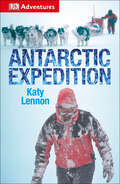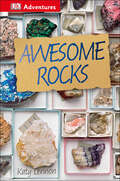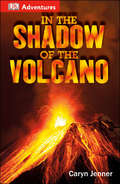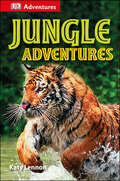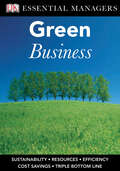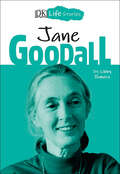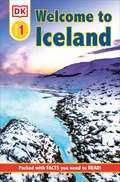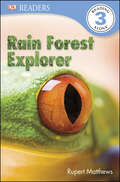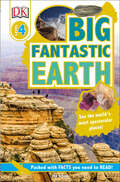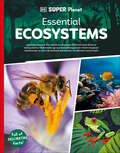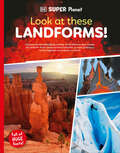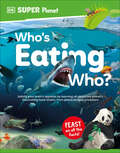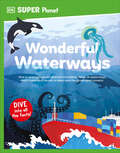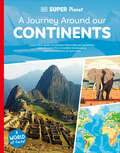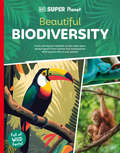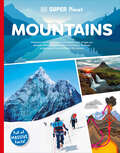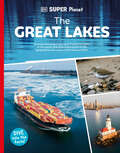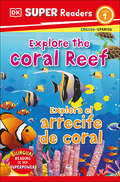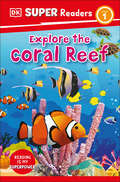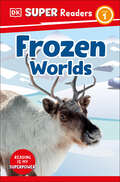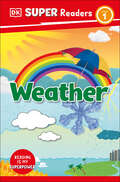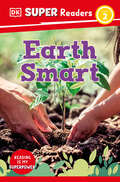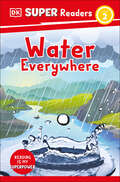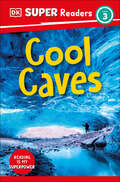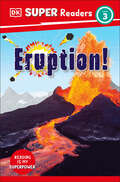- Table View
- List View
DK Adventures: Antarctic Expedition (DK Adventures)
by DKExperience the harsh conditions of this polar landscape, discover how researchers survive, and find out about the intrepid explorers from the past who have set out to reach the South Pole.DK Adventures is a nonfiction series for kids ages 8-11 featuring visually rich theme spreads, and fascinating facts that help kids build their skills in vocabulary, grammar, comprehension, and critical thinking while developing a love of reading. Designed to keep interest high, build knowledge, and enrich the reading experience with fascinating background information, each title in the DK Adventures series is filled with information yet eminently accessible, and available in a wide range of kid-favorite topics including rain forests, animals, rocks, and shipwrecks.
DK Adventures: Awesome Rocks (DK Adventures)
by Katy LennonLook up close at rocks, minerals and sparkling gems to unravel the clues to classify and identify them. Find out how they were formed, where in the world they're found and how to start your own rock collection.DK Adventures is a nonfiction series for kids ages 8-11 featuring visually rich theme spreads, and fascinating facts that help kids build their skills in vocabulary, grammar, comprehension, and critical thinking while developing a love of reading. Designed to keep interest high, build knowledge, and enrich the reading experience with fascinating background information, each title in the DK Adventures series is filled with information yet eminently accessible, and available in a wide range of kid-favorite topics including rain forests, animals, rocks, and shipwrecks.
DK Adventures: In the Shadow of the Volcano (DK Adventures)
by Caryn JennerIn a modern-day adventure of an eruption of Mount Vesuvius, a volcanologist and her son are caught up in the drama as the volcano re-awakens. The mayor is reluctant to cancel the village festival despite her warnings of an imminent eruption. Will he and the other villagers escape in time, before the explosive volcano wreaks havoc? Find out in DK Adventures: In the Shadow of the Volcano. DK Adventures are an innovative mix of narrative and nonfiction for kids ages 8-11 featuring engaging, action-packed stories that help kids build their skills in vocabulary, grammar, comprehension, and critical thinking while developing a love of reading. With diaries, recipes, poetry, instructions, graphics, or songs, the genre spreads in each DK Adventures title enhance the story and reinforce curriculum learning, while the expansive range of entertaining nonfiction subjects will appeal to boys and girls everywhere. Supports the Common Core State Standards.
DK Adventures: Jungle Adventures (DK Adventures)
by Katy LennonIs your child interested in surviving in the jungle and learning about jungle animals? DK Adventures: Jungle Adventures is the perfect book for learning more about the jungle! This book combines story and visual elements to appeal to both avid readers and visual learners. With the jungle facts and adventures story in DK Adventures: Jungle Adventure, kids might not realize they're learning at all! In DK Adventures: Jungle Adventure, we join Charlotte and a team of scientists on an expedition to explore Cambodia's wildlife. Learn how to survive and how to find animals in the jungle. Experience the mosquitoes, snakes, and torrential rain of the rainforest, and join the team as they encounter frogs, monkeys, and even a tiger! Kids will be excited about discovering the elusive Siamese crocodile, and will be eager to see if Charlotte can overcome her fear of camping. DK Adventures is a book series that reluctant readers can enjoy as much as bookworms do! This series combines captivating, fictional stories with nonfiction facts to encourage learning and engagement in your child. The stories keep children interested, and the facts teach critical skills and knowledge — the fiction and nonfiction elements work together to keep each child's interest high, to build knowledge, and to enrich the narrative reading experience with fascinating background information. These books are filled with information, but the stories make them incredibly readable. DK Adventures are available in a range of kid-friendly topics, including dinosaurs, cars, and the human body, and each book supports Common Core State Standards and literacy skills.
DK Essential Managers: Green Business (DK Essential Managers)
by Bibi van der ZeeThis concise yet comprehensive ebook gives clear guidance on how to do business ethically and sustainably, while still turning a tidy profit. It teaches the practical skills needed to do good and do well at the same time, and explains the business argument for adopting environmentally sustainable and socially responsible principles. With step-by-step instructions, tips, checklists, and &“Ask yourself&” features, the guidebook breaks down the often-intimidating process of changing your business culture and establishing long-term environmental business goals. By the end, you&’ll not only have clear picture of why a business could benefit from going green, but simple, effective guidelines for getting it done on all levels. You&’ll also be able to effectively communicate your knowledge to staff and customers, with the help of tables, illustrations, &“in focus&” panels, and real-life case studies. The text is written by Bibi Van Der Zee, environment correspondent for the Guardian and author of The Protestor&’s Handbook.DK's bestselling Essential Managers books are ideal for managers at every level. These concise references demonstrate the techniques and skills that are useful in any work environment, making them the most accessible single-subject business guides on the market.
DK Life Stories: Jane Goodall (DK Life Stories)
by Libby RomeroIn this kids' biography, discover the inspiring story of Jane Goodall, whose work with chimpanzees changed the way we understand animals and ourselves. Jane Goodall was a pioneer of primatology through her groundbreaking with chimpanzees in Africa. When she embarked on her career, women were discouraged from conducting scientific research, especially when that work meant living side by side with wild animals. Jane was a self-taught scientist, who bravely ventured out into the bush of Tanzania to discover the secret world of chimpanzees. Through perseverance and perceptive observation, she gained access to these elusive creatures and discovered that they are not so different from us. This new biography series from DK goes beyond the basic facts to tell the true life stories of history's most interesting people. Full-color photographs and hand-drawn illustrations complement thoughtfully written, age-appropriate text to create an engaging book children will enjoy reading. Definition boxes, information sidebars, maps, inspiring quotes, and other nonfiction text features add depth, and a handy reference section at the back makes this the one biography series every teacher and librarian will want to collect. Each book also includes an author's introduction letter, a glossary, and an index.
DK Reader Level 1: Packed With Facts You Need To Read! (DK Readers Level 1)
by DKWhat better way to start your reading journey than with a trip to Iceland? The land of ice and fire awaits! Did you know that Icelandic horses love to run in herds, and that the Blue Lagoon is Iceland&’s most famous hot pool? Discover many more fascinating facts about Iceland in this children&’s early reader book!Reader Level 1 Welcome to Iceland is perfect for kids ages 3-5 who are learning to read and are fascinated by other cultures. Inside, you&’ll find: • Amazing photographs that break up the text for young readers who are still building their confidence. • Labeled pictures that build a child&’s experience of reading different non-fiction genres. • Fun quizzes that support comprehension skills. Packed with incredible facts and colorful images, this non-fiction children&’s book provides an ideal balance of words and pictures for first readers. Kids will love learning about this snowy island country from the numerous volcanoes and the jaw-dropping Northern Lights to the incredible and unique Icelandic animals and culture.Developed in consultation with leading literacy experts, this geography book about Iceland is perfect for introducing children to other countries and cultures. It also helps them build general knowledge at the same time as improving literacy level.With engaging topics and fun, interactive pages, this four-level series of children&’s educational books from DK will help build a lifelong love of reading. It covers a vast range of fascinating subjects to support children as they become confident readers. More titles include Reader Level 1 Welcome to Japan, Reader Level 1 Homes Around the World and Reader Level 2 Hello Hedgehog.
DK Readers L3: Rain Forest Explorer (DK Readers Level 3)
by Rupert MatthewsIn this Level 3 DK Reader follow the blog of an adventurous young explorer through the Amazon to her Uncle's rain forest research station. In Rain Forest Explorer children able to read on their own can follow her trip along the Rio Blanco river where she goes jaguar tracking, joins tribal villagers for a feast after hunting, and discovers an ancient site. DK Readers is a multi-level reading program guaranteed to capture children's interest while developing their reading skills and general knowledge. With nine new exciting titles to choose from this season, kid's ages 4-10 will find the perfect book at their appropriate reading level to help with school projects or independent reading. Supports the Common Core State Standards.
DK Readers L4: See the World's Most Spectacular Places! (DK Readers Level 4)
by Jen GreenHow do waterfalls form? How long is the Nile River? Who led the first expedition on Mount Everest?Discover the earth's most amazing natural wonders in Big Fantastic Earth!Explore the highest peak of Mount Kilimanjaro to the deep grooves of the Grand Canyon, and discover how the incredible landscapes around the world were formed. Big Fantastic Earth takes readers on an exciting journey around the world's incredible natural architecture.Perfect for 9–11 year olds reading independently, reading becomes a fact-discovering adventure with these Level 4 readers. Supporting and encouraging a lifetime love of reading, nonfiction subjects are clearly explained, described vividly, and brought to life with true encounters, fascinating statistics, and dramatic photographic images. Additional information spreads are full of extra fun facts, developing the topics through a range of nonfiction presentation styles, such as articles, journals, and timelines.Lexile measure: 800 Fountas and Pinnell Text Level Gradient: OTrusted by parents, teachers, and librarians, and loved by kids, DK's leveled reading series is now revised and updated. With shiny new jackets and brand new nonfiction narrative content on the topics kids love, each book is written and reviewed by literacy experts, and contains a glossary and index making them the perfect choice for helping develop strong reading habits for kids ages 3–11.
DK SUPER PLANET Essential Ecosystems (DK Super Planet)
by DKJourney around the world to discover the rich and diverse ecosystems that make up our beautiful planet in this learn-to-read series.DK Super Planet Essential Ecosystems is part of the new DK Super Planet series and encourages children aged 7-11 to explore the fascinating environments on our planet.Captivating and curriculum-aligned, this book is the perfect support for learning about the wonders of our planet. It covers core scientific content, including tropical rainforests, hot and cold deserts, and savannas.This learn-to-read book for children offers:A guide to reading through curriculum-aligned content and exciting illustrations.A highly visual approach that makes the association between words and where they originate easier to understand.Material to help children become more confident readers, speakers, and spellers. Transform learning into an adventure with DK Super Planet, bringing science to life on every page. Engaging content, diagrams, and hands-on experiments provide an immersive learning experience while covering core information about why maps are an important tool. With specially designed sections that build scientific vocabulary and make complex concepts accessible to children, Essential Ecosystems is the ideal companion to any science learning.
DK SUPER PLANET Look at These Landforms! (DK Super Planet)
by DKExplore the breathtaking variety of landforms that shape our planet—from deep ocean trenches to vast plateaus and the highest mountains on Earth!DK Super Planet Look at these Landforms! Is part of the new DK Super Planet series and encourages young minds to delve into the wonders of our planet.Aligned with science and earth science curricula, this title is part of the dynamic new DK Super Planet series which invites young minds to delve into the mysteries of our planet and beyond. It covers key content, including how fossil fuels, volcanoes, and mountains are formed and how natural hazards occur.This space book for children offers:A guide to reading through curriculum-aligned content and exciting illustrations.A highly visual approach that makes the association between words and where they originate easier to understand.Material to help children become more confident readers, speakers, and spellers. Captivating and curriculum-aligned content, diagrams and hands-on experiments provide an immersive learning experience while covering core information about a range of landforms.With specially designed sections that build scientific vocabulary and make complex concepts accessible to children, Look at these Landforms! is the ideal companion to any science learning. Transform learning into an adventure with DK Super Planet, where science comes to life on every page.
DK SUPER PLANET Who’s Eating Who? (DK Super Planet)
by DKSatisfy your brain's appetite by learning all about the food chain!Aligned with science and earth science curricula, this title is part of the dynamic new DK Super Planet series which invites young minds to delve into the mysteries of our planet and beyond.Captivating and curriculum-aligned, each book in the series features engaging content, infographics, and hands-on experiments, providing an immersive learning experience. Dive into the wonders of Earth and space, with specially designed spreads that build scientific vocabulary, making complex concepts accessible to children.DK Super Planet goes beyond traditional topic books by incorporating interactive elements. Transform learning into an adventure with DK Super Planet, where science comes to life on every page, fostering a love for discovery and understanding.
DK SUPER PLANET Wonderful Waterways (DK Super Planet)
by DKDive in and explore our planet's incredible range of waterways, from rivers and canals to lakes and the great open oceans.DK Super Planet Wonderful Waterways is part of the new DK Super Planet series and encourages children aged 5-7 to explore the fascinating environments on our planet.Captivating and curriculum-aligned, this book is the perfect support for learning about the wonders of our planet. It builds background knowledge and covers core scientific content, including the water cycle, oceans, rivers, and lakes.This science book for children offers:A guide to reading through curriculum-aligned content and exciting illustrations.A highly visual approach that makes the association between words and where they originate easier to understand.Material to help children become more confident readers, speakers, and spellers.Captivating and curriculum-aligned content, diagrams, and hands-on experiments provide an immersive learning experience while covering core information about a range of ecosystems.With specially designed sections that build scientific vocabulary and make complex concepts accessible to children, Wonderful Waterways is the ideal companion to any science learning. Transform learning into an adventure with DK Super Planet, bringing science to life on every page.
DK Super Planet A Journey Around our Continents (DK Super Planet)
by DKExplore the seven continents that make up our planet and discover the incredible landscapes and environments of each one.DK Super Planet A Journey Around our Continents is part of the new DK Super Planet series, teaching children aged 7-11 about our continents and what life on each one looks like.Captivating and curriculum-aligned, this book is the perfect support for learning about the wonders of our planet. It builds background knowledge and covers core scientific content, including an explanation of what a continent is and fascinating facts about all seven.This geography book for children offers:A guide to reading through curriculum-aligned content and exciting illustrations.A highly visual approach that makes the association between words and where they originate easier to understand.Material to help children become more confident readers, speakers, and spellers.Captivating and curriculum-aligned content, diagrams, and hands-on experiments provide an immersive learning experience while covering core information about the different continentsWith specially designed sections that build scientific vocabulary and make complex concepts accessible to children, A Journey Around our Continents is the ideal companion to any science learning. Transform learning into an adventure with DK Super Planet, bringing science to life on every page.
DK Super Planet Beautiful Biodiversity (DK Super Planet)
by DKOur planet supports an abundance of life–discover the beauty and wonder of its biodiversity, from forest floors to backyard ponds.DK Super Planet Beautiful Biodiversity is part of the new DK Super Planet series for children aged 7-11 to learn all about the biodiversity of our planet.Captivating and curriculum aligned, this book is the perfect support for learning about the wonders of our planet. It builds background knowledge and covers core scientific content, including an explanation of biodiversity and an exploration of plant and animal life in different environments.This science book for children offers:A guide to reading through curriculum-aligned content and exciting illustrations.A highly visual approach that makes the association between words and where they originate easier to understand.Material to help children become more confident readers, speakers, and spellers.Captivating and curriculum-aligned content, diagrams and hands-on experiments provide an immersive learning experience while covering core information about a range of landforms.With specially designed sections that build scientific vocabulary and make complex concepts accessible to children, Beautiful Biodiversity is the ideal companion to any science learning. Transform learning into an adventure with DK Super Planet, bringing science to life on every page.
DK Super Planet Mountains (DK Super Planet)
by DKOur amazing planet is home to a diverse variety of life–learn how we can protect and conserve it for generations to come.DK Super Planet Mountains is part of the new DK Super Planet series for children aged 5-7 to learn all about different mountains and how they are formed.Captivating and curriculum aligned, this book is the perfect support for learning about the wonders of our planet. It builds background knowledge and covers core scientific content, including what plate tectonics are and an exploration of different types of mountains across the world.This science book for children offers:A guide to reading through curriculum-aligned content and exciting illustrations.A highly visual approach that makes the association between words and where they originate easier to understand.Material to help children become more confident readers, speakers, and spellers.Captivating and curriculum-aligned content, diagrams and hands-on experiments provide an immersive learning experience while covering core information about a range of landforms.With specially designed sections that build scientific vocabulary and make complex concepts accessible to children, Mountains is the ideal companion to any science learning. Transform learning into an adventure with DK Super Planet, bringing science to life on every page.
DK Super Planet The Great Lakes (DK Super Planet)
by DKDiscover the largest group of freshwater lakes in the world and their importance to the geography and environment around them.DK Super Planet The Great Lakes is part of the new DK Super Planet series for children aged 5-7 to learn all about life on and around the Great Lakes.Captivating and curriculum-aligned, this book is the perfect support for learning about the wonders of our planet. It builds background knowledge and covers core scientific content, including the characteristics of each lake, the history of the Great Lakes, and why they are so important.This geography book for children offers:A guide to reading through curriculum-aligned content and exciting illustrations.A highly visual approach that makes the association between words and where they originate easier to understand.Material to help children become more confident readers, speakers, and spellersCaptivating and curriculum-aligned content, diagrams and hands-on experiments provide an immersive learning experience while covering core information about a range of landforms.With specially designed sections that build scientific vocabulary and make complex concepts accessible to children, The Great Lakes is the ideal companion to any science learning. Transform learning into an adventure with DK Super Planet, bringing science to life on every page.
DK Super Readers Level 1 Bilingual Explore the Coral Reef – Explora el arrecife de coral (DK Super Readers)
by DKMeet the sea creatures living on a coral reef! Make reading in English and Spanish your superpower with DK&’s beautiful, leveled nonfiction.Use your bilingual reading superpowers to learn all about a beautiful coral reef and the sea animals living there - a high-quality, fun, nonfiction reader - carefully leveled to help children progress. Explore the Coral Reef - Explora el arrecife de coral is a beautifully designed reader all about the fish and other sea animals living on a coral reef. The engaging text has been carefully leveled using Lexile so that children are set up to succeed. A motivating introduction to using essential nonfiction reading skills in Spanish and English.Children will love to find out about the beautiful coral reef and all the sea animals that can be spotted on it.
DK Super Readers Level 1 Explore the Coral Reef (DK Super Readers)
by DKHelp your child power up their reading skills and learn all about a beautiful coral reef and the sea creatures living there with this fun-filled nonfiction reader carefully leveled to help children progress.DK Super Readers Level 1: Explore the Coral Reef will introduce kids to a parade of sea creatures that can be spotted on a coral reef–including exotic fish, sea turtles, sea horses, starfish, sharks, dolphins, and more–and is a motivating introduction to using essential nonfiction reading skills, proving ideal for children ready to enter the riveting world of reading. DK Super Readers take children on a journey through the wonderful world of nonfiction: traveling back to the time of dinosaurs, learning more about animals, exploring natural wonders and more, all while developing vital nonfiction reading skills and progressing from first words to reading confidently. The DK Super Readers series can help your child practice reading by:- Covering engaging, motivating, curriculum-aligned topics.- Building knowledge while progressing key Grades 1 and 2 reading skills.- Developing subject vocabulary on topics such as sea creatures, coral, and underwater exploration.- Boosting understanding and retention through comprehension quizzes.Each title, which has been leveled using MetaMetrics®: The Lexile Framework for Reading, integrates science, geography, history, and nature topics so there&’s something for all children&’s interests. The books and online content perfectly supplement core literacy programs and are mapped to the Common Core Standards. Children will love powering up their nonfiction reading skills and becoming reading heroes. DK Super Readers Level 1 titles are visually engaging and build vocabulary through a nonfiction world of amazing facts. Perfect for children ages 6 to 8 (Grades 1 and 2) who are beginning to read with help.
DK Super Readers Level 1 Frozen Worlds (DK Super Readers)
by DKWhat lives in the cold at the very top and bottom of our planet? Make reading your superpower with DK&’s beautiful, leveled nonfiction.Use your reading superpowers to learn all about life in Earth&’s frozen Arctic and Antarctic - a high-quality, fun, nonfiction reader - carefully leveled to help children progress.Frozen Worlds is a beautifully designed reader all about the Arctic in the north, home to the polar bear and the southern Antarctic, with its penguins and seals. The engaging text has been carefully leveled using Lexile so that children are set up to succeed. A motivating introduction to using essential nonfiction reading skills. Children will love to find out about the Earth&’s frozen extremes, the Arctic and Antarctic.
DK Super Readers Level 1 Weather (DK Super Readers)
by DKWhat&’s the weather like? Make reading your superpower with DK&’s beautiful, leveled nonfiction.Use your reading superpowers to learn all about all types of weather - a high-quality, fun, nonfiction reader - carefully leveled to help children progress.Weather is a beautifully designed reader all about different types of weather, from sunny days to wind and storms. The engaging text has been carefully leveled using Lexile so that children are set up to succeed. A motivating introduction to using essential nonfiction reading skills. Children will love to find out about all the different kinds of weather they may experience.
DK Super Readers Level 2 Earth Smart (DK Super Readers)
by DKBe smart about protecting our planet. Make reading your superpower with DK&’s beautiful, leveled nonfiction.Use your reading superpowers to learn all about what you can do to protect our planet - a high-quality, fun, nonfiction reader - carefully leveled to help children progress. Earth Smart is a beautifully designed reader all about two children learning how to look after the environment while having fun. The engaging text has been carefully leveled using Lexiles so that children are set up to succeed. A motivating introduction to using essential nonfiction reading skills. Children will love to find out about how they can make a difference to the environment, from recycling to not littering.
DK Super Readers Level 2 Water Everywhere (DK Super Readers)
by DKAll about water from seas to survival! Make reading your superpower with DK&’s beautiful, leveled nonfiction.Use your reading superpowers to learn all about where water comes from and how we use it - a high-quality, fun, nonfiction reader - carefully leveled to help children progress.Water Everywhere s a beautifully designed reader all about water, from seas to steam engines, and how all living things need it to surviveThe engaging text has been carefully leveled using Lexile so that children are set up to succeed. A motivating introduction to using essential nonfiction reading skills. Children will love to find out about the water cycle, uses of water, and how animals and plants need it to survive.
DK Super Readers Level 3 Cool Caves (DK Super Readers)
by DKHelp your child power up their reading skills and learn all about the coolest caves all over the world with this fun-filled nonfiction reader carefully leveled to help children progress.DK Super Readers Level 3: Cool Caves will introduce kids to a parade of unique caves around the world—from a cave that could house skyscrapers to caves of ice—and is a motivating introduction to using essential nonfiction reading skills, proving ideal for children ready to enter the riveting world of reading. DK Super Readers take children on a journey through the wonderful world of nonfiction: traveling back to the time of dinosaurs, learning more about animals, exploring natural wonders and more, all while developing vital nonfiction reading skills and progressing from first words to reading confidently. The DK Super Readers series can help your child practice reading by:- Covering engaging, motivating, curriculum-aligned topics.- Building knowledge while progressing key Grades 3 and 4 reading skills.- Developing subject vocabulary on topics such as caves, Earth&’s natural wonders, and the world around us.- Boosting understanding and retention through comprehension quizzes.Each title, which has been leveled using MetaMetrics®: The Lexile Framework for Reading, integrates science, geography, history, and nature topics so there&’s something for all children&’s interests. The books and online content perfectly supplement core literacy programs and are mapped to the Common Core Standards. Children will love powering up their nonfiction reading skills and becoming reading heroes. DK Super Readers Level 3 titles are visually engaging, full of fun facts about exciting topics, and motivate children to improve their nonfiction reading skills. Perfect for children ages 8 to 10 (Grades 3 and 4) who are newly independent readers ready to advance.
DK Super Readers Level 3 Eruption! (DK Super Readers)
by DKHelp your child power up their reading skills and learn all about the fiery mountains that are volcanoes with this engaging nonfiction reader carefully leveled to help children progress.DK Super Readers Level 3: Eruption! will introduce kids to everything they need to know about volcanoes–from where they start to what happens when they erupt, famous eruptions, and even how to make a model of one–and is a motivating introduction to using essential nonfiction reading skills, proving ideal for children ready to enter the riveting world of reading. DK Super Readers take children on a journey through the wonderful world of nonfiction: traveling back to the time of dinosaurs, learning more about animals, exploring natural wonders and more, all while developing vital nonfiction reading skills and progressing from first words to reading confidently. The DK Super Readers series can help your child practice reading by:- Covering engaging, motivating, curriculum-aligned topics.- Building knowledge while progressing key Grades 3 and 4 reading skills.- Developing subject vocabulary on topics such as volcanoes, eruptions, and the dramatic natural features of our world.- Boosting understanding and retention through comprehension quizzes.Each title, which has been leveled using MetaMetrics®: The Lexile Framework for Reading, integrates science, geography, history, and nature topics so there&’s something for all children&’s interests. The books and online content perfectly supplement core literacy programs and are mapped to the Common Core Standards. Children will love powering up their nonfiction reading skills and becoming reading heroes. DK Super Readers Level 3 titles are visually engaging, full of fun facts about exciting topics, and motivate children to improve their nonfiction reading skills. Perfect for children ages 8 to 10 (Grades 3 and 4) who are newly independent readers ready to advance.
